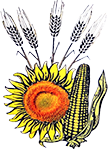Using a new Bunt Resistance Gene, Transferred from Rye in the
Wheat Breeding Program at NARDI Fundulea
Indira Galit, Matilda Ciucă, Cristina-Mihaela Marinciu, Gabriela Șerban, Alina-Gabriela Turcu,
Elena-Laura Conțescu, Alexandru-Leonard Dumitru, Vasile Mandea, Nicolae N. Săulescu
National Agricultural Research and Development Institute Fundulea
Keywords: bunt, Tilletia sp., Triticum aestivum, resistance gene, organic farming.
Abstract: Bunt, caused by Tilletia sp., is a potentially dangerous disease, especially for organic agriculture, but also as a precautionary measure for cases of wrong treatments. Damages such as losses of more than 50% or even total harvest, the depreciation of the quality of flour resulting from the grinding grains and the rejection of exports, which according to the legislation in force must not contain bunted grains, are just some of the examples that define bunt as the most damaging of wheat diseases worldwide. Considering the fact that the symptoms are visible only when the plants are mature, the control of the spreading of the disease is achieved by treating the seeds with chemical fungicides, biological fungicides or directly by cultivating varieties with genetic resistance. Currently, 16 resistance genes (Bt) and 23 QTLs are known, but due to the low durability, the identification of new genes is needed. Research at NARDI highlighted the line F00628G34, which possesses a gene that provides resistance to bunt, a gene not yet named, associated with the 1A-1R translocation from rye. The results obtained after testing 76 DH lines from the F628/Izvor cross under artificial infections showed that the lines with rye DNA were 50% free of attack and had a maximum attack of 12%, and those without rye chromatin had had up to 40% attack. The new resistance gene offers good protection to the bunt races from Romania and partial resistance to some races from Western Europe. The new bunt resistance gene was intensively used in the wheat breeding program of NARDI Fundulea, being present in the Ursita and FDL Abund cultivars, recently registered, in two perspective lines in the last year of official testing at SIVTR and in a proportion of up to 59% in the various breeding stages. The close association of this gene with a molecular marker facilitates the pyramiding with other resistance genes, to improve the efficiency and durability of the protection against bunt. Currently, there is already material in the F3 generation that combines the new gene and the Bt10 gene.
